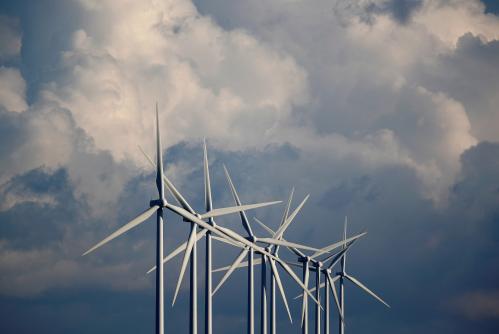This blog draws from the new working paper, “Blending climate funds to finance low-carbon, climate-resilient infrastructure,” which can be downloaded here.
Infrastructure and Climate Change
The world’s core infrastructure—including our transport and energy systems, buildings, industry, and land-related activities—produce more than 60 percent of all greenhouse gas (GHG) emissions globally. At the same time, the world has significant infrastructure needs. From 2015-2030, approximately $90 trillion of infrastructure investment is needed, a doubling of the global capital stock.
Yet, unless the new infrastructure is low-carbon and climate resilient (LCR), the world will be locked into a high-carbon pathway and will miss the Paris Agreement’s goal of keeping the global average temperature increase well below 2 degrees Celsius by 2050. LCR infrastructure includes renewable energy, mass transit, and energy efficiency.
Meeting LCR infrastructure needs will require an additional $13.5 trillion in renewable energy and energy efficiency. Moreover, infrastructure investment consistent with the below 2 degree scenario will also require a reallocation of investment, with less investment in carbon intensive infrastructure and less infrastructure needed due to more compact cities. In fact, the net increase in needed LCR infrastructure is around $4 trillion over 15 years. And this does not take into account savings from lower operating costs of LCR infrastructure, estimated at around $5 trillion. These figures underscore the broader point that there is no inherent trade-off between building LCR infrastructure and development.
Infrastructure and Development
Whether the world builds LCR infrastructure will also determine whether the Sustainable Development Goals (SDGs) are achieved. Around 70 percent of LCR infrastructure needs are in developing countries. Building LCR infrastructure links the climate and development agendas in multiple ways. For one, the poorest and most vulnerable people in developing countries are feeling the impact of climate change most acutely. This link between climate change and poverty is reflected in the SDGs, which recognize addressing climate change as a development outcome.
Infrastructure also has a direct effect on development. For instance, building renewable energy production instead of coal-fired power plants can reduce air pollution and produce better health outcomes. And building compact cities with access to mass transit affects access to other key services such as health and education.
Financing LCR infrastructure—the need for increased private investment
A key challenge is financing the needed LCR infrastructure. Because public finances are constrained, 35-50 percent of incremental infrastructure investment will need to come from the private sector.
Another reason to increase private investment into infrastructure is to harness the efficiency gains from private sector construction and operation of such infrastructure.
Fortunately, there is no shortage of private capital globally: institutional investors have $85 trillion in assets under management and expect to have over $110 trillion by 2020. Yet, current allocations from institutional investors into infrastructure are low—approximately 1 percent of total asset allocations. There is also a shortage of other private capital for infrastructure, particularly LCR infrastructure in developing countries.
The lack of investment in infrastructure is due to infrastructure risks and other barriers. Moreover, LCR infrastructure carries particular risks. These include limited investment track records for new climate technologies, and reliance on government support such as feed-in-tariffs or subsidies. LCR infrastructure risks are also higher in developing countries, where there is greater political instability, poor investment environments, and currency risks.
In addition, the lack of carbon price and fossil fuel subsidies effectively subsidize investments in carbon-intensive infrastructure. As a result, the full social costs of such investments—the negative climate and development impacts—are not properly reflected in these investment decisions.
LCR infrastructure risks also vary over the project lifecycle. Risks are high in the early project preparation stage due to challenges with developing complex infrastructure plans and obtaining permits. As project construction commences, risks grow due to macroeconomic and business uncertainties, as well as possible construction delays, permit cancellations, and sudden shifts in the availability of finance. Only once the project is operational does cash flow turn positive, risks decline, and it can deliver a return on investment.
A consequence of these LCR infrastructure risks is that the cost of capital climbs and finance becomes scarce. This, in turn, stymies LCR infrastructure projects and diverts investment into what is often lower cost, higher-carbon alternatives.
Addressing these LCR infrastructure investment challenges requires aligning public and private finance in a manner that allows the full risks to be borne.
Blending finance for LCR Infrastructure
Combining sources of public finance—such as from multilateral development banks (MDBs) and climate funds—is a form of blended finance that can reduce risk, lower the cost of capital, and crowd-in private sector capital into LCR projects.
The MDBs have the knowledge and financial position to play a central role in blending their own capital with climate finance to reduce risk and crowd-in private sector capital. The MDBs are increasing their climate investments, yet they face constraints in terms of the amount of finance they can provide and the risks they can accept.
The main multilateral climate funds (MCF) are the Climate Investment Funds, the Green Climate Fund, and the Global Environment Facility, which are all blended finance facilities designed to co-finance with other public and private sources of capital.
The MCF can have the greatest impact by addressing financing barriers to LCR infrastructure by providing small amounts of highly concessional finance alongside other public finance to reduce risk and crowd-in private capital into transformative LCR projects.
While MDBs are also a source of concessional finance, the MCF lend at even more concessional rates, particularly to middle-income countries where climate and LCR infrastructure needs are most acute.
A key focus for MDB and MCF is to improve countries’ enabling environments, which can reduce LCR infrastructure risk across the infrastructure project lifecycle. This includes strengthening countries’ investment environment and institutional capacity. The MDBs make such investments to improve development outcomes, including more targeted support under the Global Infrastructure Facility. Yet, even here, such investments do not necessarily support LCR infrastructure. This is where the MCF can boost country-level capacity to assess LCR alternatives and build a pipeline of LCR infrastructure projects, develop the capacity to use best available climate technology, and build consideration of the below 2 degree Celsius climate goal into the project preparation stage.
Larger amounts of finance are needed at the project construction phase and it is at this point that high costs of capital can render infrastructure projects financially unfeasible. Here, blending finance from the MDBs and the MCF can reduce risks to attract private sector capital into transformative climate technologies in developing countries.
Moreover, as the MDBs ramp-up their climate financing and are guided by the cascade approach to finance, which emphasizes risk mitigation before direct loans, the MCF should be prepared and able to address the remaining financing gaps.
The Brookings Institution is committed to quality, independence, and impact.
We are supported by a diverse array of funders. In line with our values and policies, each Brookings publication represents the sole views of its author(s).






Commentary
How do we finance low-carbon infrastructure?
July 19, 2018